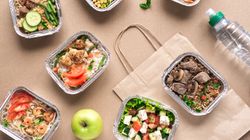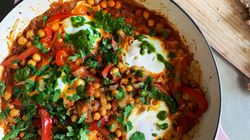If you find yourself throwing out mouldy berries, stale pieces of bread and wilted lettuce on a regular basis, you’re not alone.
But with a little bit of intention, you can use up all those random ingredients you find in your kitchen. We went to the experts for the best tips and tricks for using up all the odds and ends in your fridge and pantry.
Choose A Theme Instead Of A Specific Recipe
When it comes to using up tidbits from your fridge, Clare Langan, a home-cooking expert who was a producer on the A&E cooking show “Scraps,” recommends loosely planning meals by theme instead of adhering to specific recipes.
“Each week, or a couple of times a week, roughly plan out your meals for the next few days based on what you have in the house,” Langan tells HuffPost. “Right now, especially, it’s unrealistic to assume you have everything in your house to whip up a specific recipe. I recommend opting for a looser approach: Meatless Mondays, Taco Tuesdays, Pasta Sundays. Putting a little intention behind how you plan and shop can be helpful if you have trouble deciding what to make and end up wasting food. Plus, theme nights make dinner feel a little more special.”
Adam Stevenson, executive chef of the Copperleaf Restaurant at Seattle’s Cedarbrook Lodge, seconds a taco theme as a great way to use up the odds and ends from your fridge. “When we have tacos, we use lots of different vegetables as toppings, keeping them raw for the best nutrients and crunch,” he says. “Vegetables we like are kale, cabbage, carrots and radish. These, tossed with apple cider vinegar, olive oil and lemon, add that nice crunch to the taco.”
Incorporate Leftovers Into Your Meal Plan
When Stevenson is at home, he looks forward to eating leftovers, he says. “We look at this as an opportunity to make something else great. For instance, from a roasted or smoked chicken, we will pick the remaining meat and have tacos the next day. From the carcass, we make a wonderful stock. One that comes to mind is pho. It’s great paired with that leftover pork roast from a few nights ago. The same broth is fantastic for making soups or pasta dishes.”
Langan also loves cooking with leftover broth or stock, especially when cooking grains such as rice or quinoa or simmering dried or canned beans. “This is a great trick to make canned beans taste more like those from scratch,” she says.
Langan calls pizzas, vegetable soups, grain bowls, tacos, frittatas and grilled cheese sandwiches “use-it-up meals” and recommends using them as blank slates to fill up with all the leftovers and random items from your fridge.
Master The ‘Fridge Dive Frittata’
Langan suggests purging your fridge before you head to the shop. “Once a week, before going to the supermarket, make a Fridge Dive Frittata. Cook any vegetable odds and ends in your fridge ― the remaining half of an onion, a handful of wilted spinach, the last of a bag of frozen peas ― in an oven-proof skillet. Add six to eight whisked eggs in a small to medium skillet and any other bits from your fridge. This is a great place for cheese and herbs. Bake at 350 degrees Fahrenheit for about 30 to 40 minutes until set. This is particularly good for brunch, but you can eat it any time of the day!”
Don’t Throw Away Your Stems
It pains Stevenson when you throw away the lesser parts of vegetables. “One way to get more out of your vegetables and preserve them is to use the entire vegetable,” he says. “One of my favourite things to eat are the stems and stalks of broccoli and romaine. These are wonderful pickled, roasted or simply sautéed. There is no reason to get rid of them ― this is where all the flavour and nutrients are.” Here are five delicious uses for broccoli stems.
Save Your Stale Bread
It may be tempting to throw away stale pieces of bread, but they can actually be frozen until you’re ready to put them to use.
Langan has some terrific tips for this. “Another catch-all dish is panzanella, also known as bread salad.Tear pieces of bread (fresh or stale) into bite-size pieces and toast lightly in the oven. Toss with your favourite vinaigrette and any odds and ends ― vegetables, cheese, herbs or cooked protein or beans. Tomatoes, basil and mozzarella are classic, but use what you have! I like doing a version with cucumber, dill, feta and red onion for a Greek vibe.” Click here for more panzanella salad recipes.
She also suggests blitzing leftover bread into crumbs and toasting them in a skillet with olive oil, garlic and herbs to make a crunchy topping for pasta, salads and soups.
Get Creative With Fruit And Berries
Anyone who has ever purchased a banana knows that some foods, especially fruits and berries, have a short shelf life.
A lot of vintage baking recipes were created as a way to use up fruit before it went bad, Langan says. “Crumbles, crisps, buckles and pandowdy are all great ways to use up berries, stone fruit, apples and pears. You can also simmer about-to-turn fruit with a bit of sweetener like sugar, honey or maple syrup in a saucepan until thickened for a quick compote to top ice cream, cakes, yogurt or oatmeal.”
If you’re freezing fruit to use later in smoothies or other recipes, Langan says to cut the fruit into 2-inch pieces, place on a parchment or waxed paper-lined sheet tray and freeze until solid. Then transfer the fruit to an airtight container or zip-top bag. “Freezing the fruit this way allows it to become like little ice cubes rather than freezing into one big clump,” she says. She also suggests peeling bananas first, since it can be difficult to remove the skins once they’re frozen.
You shouldn’t neglect ripening avocados, Stevenson says. “These turn ripe so fast, especially during hot days,” he says. “Get them into your salads. If they’re too soft, make a mayonnaise or a green goddess dressing.” These green goddess recipes will remind you of its greatness.
Learning how to use all the odds and ends in your kitchen will save you money, and the results are nothing short of delicious.


